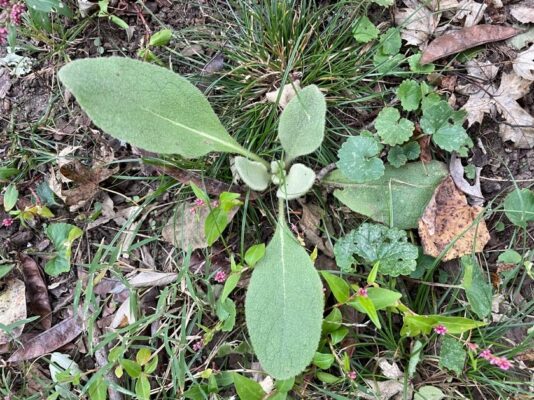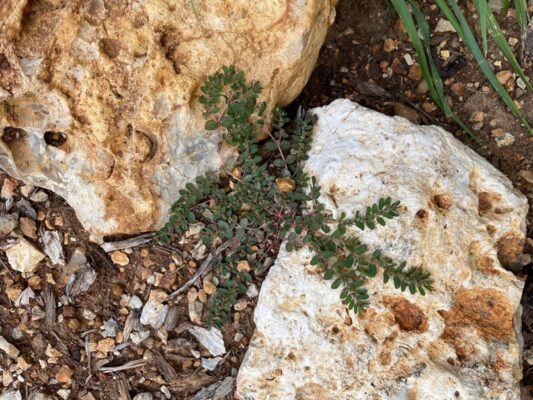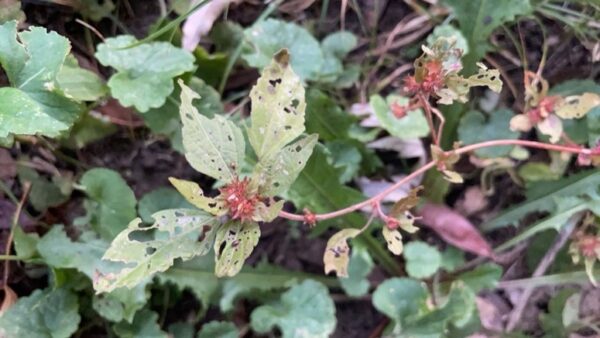 by Erin Goss, Chapter member and Native Plant Initiative Coordinator for Shaw Nature Reserve
by Erin Goss, Chapter member and Native Plant Initiative Coordinator for Shaw Nature Reserve
According to a Scotts-MiracleGro press release, sales for lawn and garden-related products in FY 2023 topped $3.55 billion. Advertising and convention tell us that gardens are higher in maintenance than a lawn. Yet anxiety over ‘weeds’, especially lawn weeds, is reflected in Scott’s-MiracleGro’s spectacular growth over the last decade. Many weeds are useful – dandelion, plantain, mullein, chickweed – and many are just wrong plants in the wrong place. Or we create the conditions for their exponential proliferation – as in the case of lawns and gardens: loose textured soil, frequent disturbance, extra waterings.
 July’s Native Plant School Class focused on defining a weed as “a plant that is unwanted in a cultivated space”. We discussed mostly mechanical management strategies based on type of plant (perennial, annual, biennial, etc.), and learning key identifiers to help us spot weeds before they become problems.
July’s Native Plant School Class focused on defining a weed as “a plant that is unwanted in a cultivated space”. We discussed mostly mechanical management strategies based on type of plant (perennial, annual, biennial, etc.), and learning key identifiers to help us spot weeds before they become problems.
Most annual weeds like marestail, prickly lettuce, goosegrass, and large crabgrass, can be managed by cutting off and disposing of seed heads. Since annuals complete their reproductive cycle in one year, removing seed heads removes the plants’ ability to reproduce. Another approach is to cut the whole plant to the ground, let it regrow, and then cut it back again. This death by attrition inhibits photosynthesis and robs the plant of the ability to replace the depleted nutrients in its roots and eventually the plant dies. Perennial weeds (yellow nutsedge, creeping Charlie, Bermudagrass, horse nettle) respond to this method fairly well, too. Though perennial weeds that spread by rooting nodes or rhizomes can be tricky to remove. Pulling the plant, roots and all, can be the best approach, especially if the plant is young and the ground is slightly moist (like the day after a rain). Pulling a plant by the roots, however, will always disturb the soil to an extent and increase the likelihood of soil banked seed germination.
 If you’re a book person, check out Weeds of North America by Dickinson & Royer – available in paperback and e-book from the University of Chicago for detailed instruction in weed identification; or the University of Missouri’s Weed ID Guide, an online database and key. Many university extensions have information about weeds – though much of this information centers on agricultural and turfgrass weed species and locations.
If you’re a book person, check out Weeds of North America by Dickinson & Royer – available in paperback and e-book from the University of Chicago for detailed instruction in weed identification; or the University of Missouri’s Weed ID Guide, an online database and key. Many university extensions have information about weeds – though much of this information centers on agricultural and turfgrass weed species and locations.
Sign up for upcoming classes, space is limited
- August’s Native Plant School class: Native Landscaping for Drought Tolerance with guest instructor, Shannon Callahan (Bring Conservation Home).
- September’s Native Plant School class: Native Plant School: Observing Fall in the Whitmire Wildflower Garden at Shaw Nature Reserve with instructor Donald Frisch
You can sign up by clicking the hyperlink above or browse the full Missouri Botanical Gardens class catalog. Hope to see you there!

